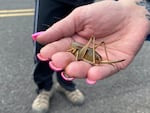Since at least 2020, Oregon farmers and ranchers in the southern and eastern regions of the state have dealt with some of the worst grasshopper infestations in decades, resulting in crop and economic losses in those communities.
To minimize the damage, the Oregon Department of Agriculture will distribute $100,000 each to five of the most impacted counties. Additional funds are also on hand to respond to infestations as they arise.
Several grasshopper and cricket species, like the Mormon cricket — actually a type of katydid — are native to Oregon and much of the Western United States. But years of hot weather and low rainfall can create the ideal conditions for the population of the insects to explode.

Grasshoppers and Mormon crickets are natural components of the rangeland ecosystem. However, when their populations reach outbreak levels, they can result in crop and economic losses for farmers and ranchers.
Lance Cheung / U.S. Department of Agriculture
In the summer of 2021, Oregon had one of the worst infestations. Agriculture officials estimated over 10 million acres of rangeland across 18 counties experienced outbreaks. It’s bad news for farmers because the insects tend to munch and decimate fields of grains and grass like alfalfa that go to feed livestock.
Though last year’s swarms were not as far reaching, they were still a problem for many producers. Officials estimated over 2 millions acres experienced an infestation.
Scott White, the general manager of the Klamath Drainage District, said the outbreaks have been getting worse every year. He said when it’s dry, it’s not unusual to see dust clouds coming from the southern region of Klamath County, but last year was different.

FILE: April Aamodt holds a Mormon cricket in her hand in Blalock Canyon near Arlington, Ore., on June 17, 2022. Aamodt was involved in local outreach for Mormon cricket surveying.
Claire Rush / AP
“Last year we were seeing something really similar but they were actually grasshoppers [swarms],” White said. “It was something like I’ve never seen before. And there’s a lot of growers here that have been around a long, long time that can’t recall ever seeing grasshoppers in the numbers that we saw.”
It’s why the state’s department of agriculture is allocating $100,000 per county to the most severely impacted areas, Baker, Harney, Klamath, Lake and Malheur counties.
Oregon earmarked $1.2 million for grasshopper mitigation through Senate Bill 5701 — the Legislature’s catch-all, end-of-year spending bill — during the last legislative session. It’s not the first time the state has spent money to fight the insects. In 2022, the Oregon Capitol Chronicle reported the state set had aside $5 million in grants to reimburse producers for the cost of spraying the insects.
This time, it’s largely up to the counties to determine the best use of the funds. The department of agriculture will also distribute $425,000 to any county that needs money to treat infestations, said Sunny Summers, senior policy adviser at ODA.
“We’re seeing these insects hatch earlier than we would traditionally,” Summers said. “And so people are feeling very anxious about getting out and treating them so that they don’t get to that point where they lay eggs and we continue to have a problem in future years.”
As an example of how farmers can use the funds, Summers said, commissioners in one county decided they’ll use the money to establish a cost-sharing program, where the county pays for 75% of expenses and the grower pays for the other 25% for the cost of labor and insecticide application.
The idea is to help farmers with the cost of spraying more vulnerable newborn insects, before they mature and cause more problems to Oregon’s food supply and local ecosystems, Summers said.
As the warm weather settles in and the insects begin to hatch, White said, he anticipates the funds will go fast but he feels farmers and ranchers are at least better prepared.
“We’re preparing for a year like last year, but I would say we’re certainly on it a whole lot better, we’re paying attention and we know what to look for,” White said.


